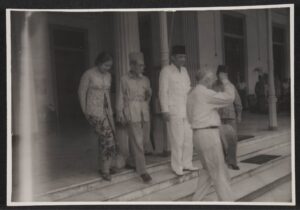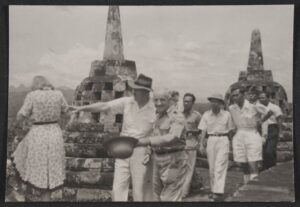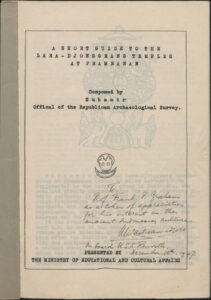Dr. Frank on the Ground in Indonesia
This page is the sixth of nine in a virtual exhibition on Frank Porter Graham’s role in negotiations for the recognition of Indonesian independence. See the homepage for the exhibition here. See the previous page here. See the next page here.

On November 10, anticipating Armistice Day (Dr. Frank had served in Europe during the First World War, so it was a day of great personal significance to him), he wrote back to his wife Marion about the heavy pace the committee was keeping.
I sent you pictures of our arrival both in the Dutch capital of Batavia [now Jakarta] and in the Republican capital of Jogjakarta. We have been constantly on the go, but are holding up well. … I have been to receptions at the Lt. Gov. General’s house, at the President’s house in Jogjakarta, etc. etc. If the President’s wife sends you a receipt for a delicious soft drink, please write her a prompt thank you.[1]
In other letters, he writes about riding through the countryside around Jakarta, eating spicy food (a challenge for the committee, it seems), and the warmth of all the Indonesian people he met when travelling. He never quite got used to riding on the other side of the road (Americans drive on the right; Indonesians on the left).

When in Yogyakarta, the Indonesians made a special point of taking Dr. Frank and the other members of the committee to some of the classical heritage sites around the city. This included the Buddhist ruins at Borobudur, and the Hindu temple ruins at Prambanan. The Indonesian side even drew up a special archeological briefing for Dr. Frank and his colleagues on Prambanan—well-tailored for a history professor acting as a diplomat. This report is now in Dr. Frank’s papers with a special dedication from Ali Sastroamijoyo, later Prime Minister of Indonesia, on December 12, 1947. During meetings with the Indonesian negotiators, the Committee of Good Offices was also treated to performances of Javanese traditional dance.

[1] Letter from Frank Porter Graham to Marion Graham, November 10, 1947, in the Frank Porter Graham Papers, Wilson Library, UNC-Chapel Hill, folder 1982.
Further Reading:
The Buddhist ruins at Borobudur and the Hindu ruins at Prambanan, both outside of Yogyakarta, have long served as foci of cultural nationalism and pride for Indonesians—despite the fact that it is a majority-Muslim country. Emily Scolaro (now a doctoral candidate in Anthropology at UNC-Chapel Hill) has written about “Nationalism and Cultural Heritage: A Local Study of Borobudur Temple.” The use of Borobudur as a symbol of Indonesian greatness has been much debated, including by Benedict Anderson in “Cartoons and Monuments: The Evolution of Political Communication under the New Order.”
